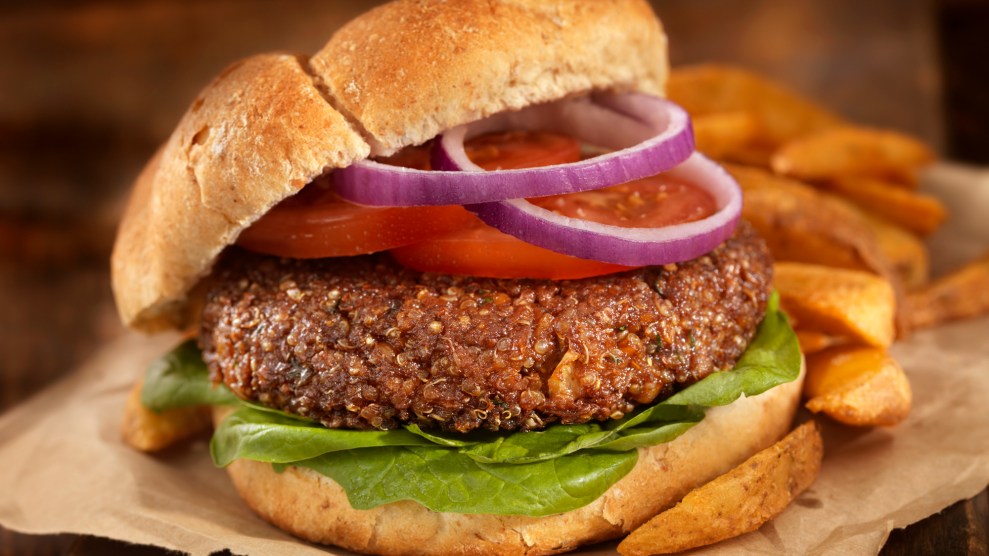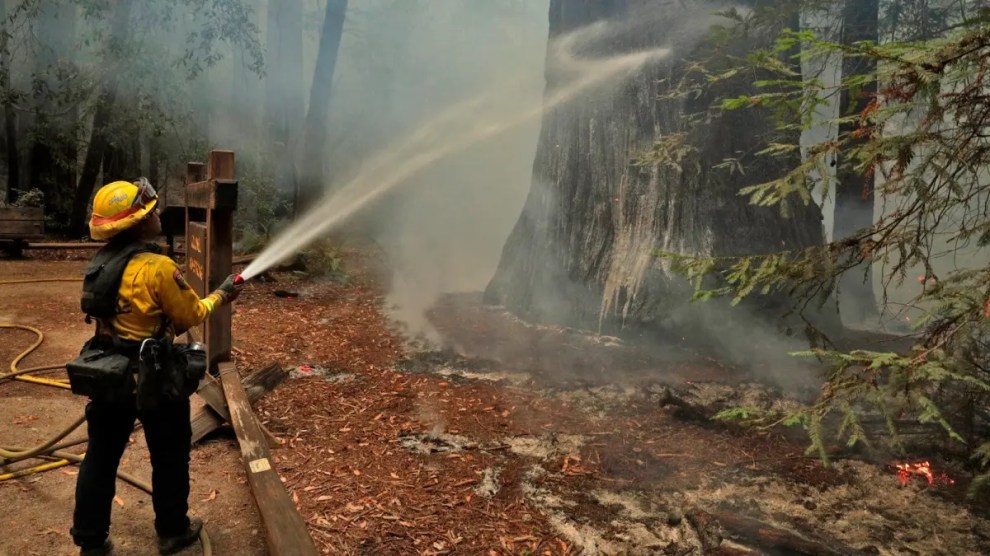About a decade ago, Silicon Valley cash began flowing into startups that promised hyper-realistic imitation meat—not your hippy uncle’s tofu pup or garden burger, but facsimiles that taste (and “bleed“) just like the real thing. Nearly from the start, one model for the project kept popping up: Tesla. Buoyed by a hefty dose of venture capital, the company had leapt past the hidebound auto industry and in 2012 began churning out all-electric vehicles that quickly became the toast of the luxury car market—embraced not just for their environmental friendliness, but mainly for their design and performance (a few pesky fires aside). In short, the argument went, Tesla broke through because its cutting-edge technology made a better car, not because it made a greener car. You didn’t have to give a damn about climate change to covet one.
The faux meat upstarts vowed to to something similar with meat: They’d make burgers as delicious as the real thing, and lure in carnivores who don’t care about industrial meat’s environmental impacts, like greenhouse gas-spewing cow burps and manure “lagoons,” or its social flaws, such as gruesome working conditions in slaughterhouses. “We’re changing the rules of game, let’s build the Tesla of meat,” Ethan Bown, CEO of Beyond Meat, told a trade journal in 2015. “It feels to me that what you’re trying to do in meat is what Tesla did in electric cars,” journalist Ezra Klein gushed to a clearly pleased Patrick Brown (no relation to Ethan), founder and CEO of Impossible Foods, on his podcast in 2016. A year later, Impossible declared an ambitious goal: “Impossible Foods wants to supply people with all the delicious, nutritious and affordable meat they want,” the company’s 2017 sustainability report states. “We want to replace a prehistoric means of food production with one that can sustainably feed 10 billion people by 2050.”
In both cases, the underlying idea was that better consumer choice—enticing us to buy a greener car or burger—could drive the kind of societal change needed to rein in global warming, if only entrepreneurs could hit upon the right technical breakthroughs.
Much has changed in the years since. Both Tesla and meat-that’s-not-meat startups have experienced meteoric rises and come down to earth a bit. For all their achievements and market penetration, the incumbent industries they aimed to disrupt—Big Oil and Big Meat—are chugging along. And the whole model of a consumer-led, tech-centered approach to climate change is looking tattered.
To see what I mean, check out the trajectory of Beyond Meat. In 2015, it emerged as a media darling, typified by an Outside Magazine piece titled “This Top-Secret Food Will Change the Way You Eat.” In it, writer Rowan Jacobsen reported he had gotten an early taste of the company’s soon-to-debut Beast Burger and it had convinced him to give up meat. He described the experience:
I tossed one on the grill. It hit with a satisfying sizzle. Gobbets of lovely fat began to bubble out. A beefy smell filled the air. I browned a bun. Popped a pilsner. Mustard, ketchup, pickle, onions. I threw it all together with some chips on the side and took a bite. I chewed. I thought. I chewed some more. And then I began to get excited about the future.
Jacobsen reported that Beyond had achieved pea-burger nirvana by hiring Tim Geistlinger, a “biotech rock star who had been working with the Gates Foundation to develop antimalarial drugs and a yeast that makes clean jet fuel out of sugar.” (Note: Jets still fly on fossil fuel). But Geistlinger couldn’t quite describe to Jacobson the technological feat that had made that Beast Burger so tasty—because it was proprietary information. “Eventually, Geistlinger suggested trying something radical—the big Beast Burger secret, which involves a certain combination of temperature, pressure, timing, and chemistry that he could tell me about only in veiled terms,” Jacobsen wrote.
That “certain combination of temperature, pressure, timing, and chemistry”—the burger’s special sauce, so to speak—served the company well for a while. The Beast was a hit, and a year later, it gave rise to an even more-popular successor called the Beyond Burger, which the company hailed as “our new ‘raw-beef’ style burger that looks, cooks, and tastes so much like beef [that] it’s being shelved in the meat sections at Whole Foods.”
After that product, too, took off, Beyond took its shares public in May 2019—and Wall Street proved as ravenous for imitation meat as Silicon Valley. On the day of the initial public offering, Beyond shares surged 192 percent, the best-performing US IPO raising at least $200 million “since before the 2008 financial crisis,” Bloomberg reported. By the end of its first day of trading, Beyond’s market value stood at $3.8 billion—a heady level for a company that had never turned a profit. Riding a wave of hype, the company’s shares tripled within three months.
But things have been rocky ever since, and in 2022, Beyond stock has plunged. At its current share price, the stock market values Beyond at $1.5 billion, just 10 percent of the all-time high it reached in 2019. And the giant companies Beyond hoped to topple are doing just fine. Over the past year, while Beyond shares were sliding 84 percent, the stock of its animal-based meat rival Tyson jumped 12 percent, outperforming the overall market. What happened?
While Beyond was riding high in 2019, the established food industry was taking note of its success and plotting its response. In a November 2019 piece, the Washington Post’s Laura Reiley reported that meat-processing giants Cargill, Tyson Foods, and Smithfield, along with Kellogg’s and other processed-food titans, had engaged their formidable flavor-engineering R&D teams to take on Beyond and other newcomers in a “headlong race to produce signature plant-based meats.” The upstart had awakened the sleeping giant.
As competition from those well-capitalized players heated up, plant-based meat sales boomed during the height of the pandemic in 2020. But over the past year, sales growth has flattened or even gone negative, according to various market-data firms. “Consumers aren’t embracing [high-tech burger and other meat facsimiles] with the same level of enthusiasm they did a few years ago,” Bloomberg’s Deena Shanker reported in May, after Beyond disappointed Wall Street with lower-than-expected revenues. “Many no longer see the products as healthy, citing concerns over how processed they are. Others are turning away after trying one product they don’t like.”
Today, after all the bluster, Beyond owns a 20 percent share of the US plant-based meat market, second to Morningstar, an old school veggie-burger brand now owned by Kellogg’s, which owns a 27 percent slice, reports CNBC. Apparently, Geistlinger’s top-secret “combination of temperature, pressure, timing, and chemistry” wasn’t quite the killer app Beyond and its boosters thought it would be seven years ago.
Impossible Foods clocks in at third, owning 12 percent of the plant-based meat market. It has a story similar to Beyond’s: loads of investor and media adulation and a special-sauce technology (genetically modified “heme“) said to make soy-protein patties taste just like beef. In 2019, the company announced what it called a “simple mission: to replace the need for animals as a food-production technology–globally, by 2035.” While Impossible reports that sales are booming—it claimed in March that quarterly revenues had jumped 85 percent over the previous year’s—it has yet to go through with its long-anticipated IPO. That hesitation is just another signal of Wall Street’s lost appetite for high-tech faux meat players.
Ironically, Tesla, Impossible’s and Beyond’s role model, finds itself in a similar place. After early investor Elon Musk took the company’s CEO position in 2008 (he now also serves as its “technoking“), Tesla rode a wave of hype—and generous public subsidies, despite Musk’s avowed fiscal conservatism—to dizzying heights. While the entrenched automotive industry kept churning out gas-burning SUVs, along with hybrids for green cred, Tesla ramped up production of high-performing all-electric vehicles.
The media took note. In a 2013 profile typical of Musk’s press from that era, The New Yorker’s Tad Friend hailed Musk’s “manifest determination to save the world—single-handedly, if necessary.” Wall Street bought in, too. The company’s stock rose steadily from 2013 to late 2019—at which point it took flight like a rocket from Space X, another Musk company. By October 2021, the stock market valued Tesla at an extraordinary $1 trillion—more than the combined valuation of five well-established competitors (Toyota, VW, Daimler, Ford Motor, and GM). And for a time, its CEO enjoyed status as the world’s richest human.
But simultaneously, Musk fixated on an even more ambitious goal than ending the internal-combustion car: creating ones that can drive themselves. Safe self-driving vehicles have proven much more elusive than Musk and other boosters claim, experts say. But that hasn’t stopped Musk from declaring their imminent arrival. (In a San Francisco pilot project, Tesla rival Chevrolet has just begun running a small fleet of fully autonomous all-electric taxis, which can only operate when all of these conditions hold: good weather, nighttime, and low traffic.) Here’s a supercut video of Musk promising autonomous Teslas “next year,” every year between 2014 and 2021. And just two weeks ago, on a trip to Brazil, he extended that streak to 2022. Meanwhile, the company has insisted on offering features called “Autopilot” and “full self-driving,” which despite their confident names, “are intended for use with a fully attentive driver, who has their hands on the wheel and is prepared to take over at any moment,” the Tesla website states. The company hails the safety of Autopilot, but it has come under investigation by the National Highway Traffic Safety Administration for reportedly causing Teslas to crash into emergency vehicles and, more recently, for “allegations of unexpected brake activation” in recent-year models.
While Tesla keeps generating alarming headlines (“US has over 750 complaints of Teslas braking for no reason,” AP reported on June 3), its old-line competitors are successfully rolling out their own all-electric cars, though they’ve been stymied this year by a chip shortage. In early June, Musk told Tesla executives in an email that he intended to lay off 10 percent of the company’s salaried staff because of his “super bad feeling” about the economy, Reuters reported. Jostled by fast-emerging competition, safety issues, and the technoking’s erratic lunge to buy Twitter, Tesla shares have surrendered more than a third of their value over the past two months.
The whole notion that replacing every gas-burning car on the road today with a nifty electric model is looking less and less like a planet-saving panacea. Just like oil, rising demand for minerals to power EVs is generating massive geopolitical tensions, and threatens to trigger a cold war with China. Here in the United States, the scramble for copper, largely to satisfy the EV boom, has given rise to a vast proposed mining project atop sacred Apache ground in Arizona that “threatens to deplete groundwater as the Southwest faces a historic megadrought,” my colleague Maddie Oatman reported recently. Thea Riofrancos, a political scientist at Providence College, has documented the ill effects on mining lithium for EV batteries in places like Chile’s Atacama salt flat, where extraction operations require “enormous quantities of water in an already parched environment,” making freshwater “less accessible to the 18 indigenous Atacameño communities that live on the flat’s perimeter,” and disrupting the habitats of species such as Andean flamingos.
In short, as Riofrancos put it, a “transportation system based on individual electric vehicles…with landscapes dominated by highways and suburban sprawl, is much more resource- and energy-intensive than one that favours mass transit and alternatives such as walking and cycling.” While many reporters were marveling at the wonder (and glitches) of Musk’s cars, the US mass transit network has sunk ever deeper into decay. In its “2021 Report Card for America’s Infrastructure,” the American Society of Civil Engineers gave the the nation’s transit system a “D-,” finding that nearly half of Americans lack reliable access to transit service. (Musk’s own answer to mass transit, getting cities to pay his Boring Company to dig tunnels and ferry people underground in Teslas, is absurd.)
And suburban sprawl, as American as a hulking Ford F150 (now available in an all-electric version), proceeds apace. “Between 2001 and 2019, the built-up landscape of America—buildings, roads and other structures—has expanded into previously undeveloped areas, adding more than 14,000 square miles of new development across the contiguous United States—an area over five times the size of Delaware,” the Washington Post found last year. The phenomenon is most prominent in the Sun Belt stretching from Florida to Southern California—the very region with the least mass transit infrastructure.
Just as the rise of techy meat substitutes have so far failed to dent the US appetite for meat—currently near all-time highs—Musk’s successes don’t seem capable of stemming the mounting environmental wreckage of the Anthropocene. Maybe striving to build the “Tesla of meat”—or of anything—was always a wrong turn. Or at best it was a supplement to, but not a replacement for, the real political work of reining in the abuses of our lightly regulated, powerful meat and fossil fuel industries.

















